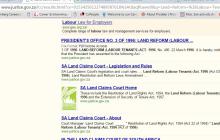/ library resources
Showing items 1 through 9 of 9.The relationship between land ownership and the sustainable use of natural resources is examined within the context of constitutional change in Africa.
Looks at land ownership and the consequences of land degradation in Kenya.Contains interview with IDRC personnel Harmut Krugmann.
The overall aim of the National Land Policy is to promote and ensure a secure land tenure system, to encourage the optimal use of land resources, and to facilitate broad-based social and economic development without upsetting or endangering the ecological balance of the environment.
The National Land Policy was adopted by Jamaica in 1997 as a national policy for the land sector.
To enable communities to form juristic persons, to be known as communal property associations in order to acquire, hold and manage property on a basis agreed to by members of a community in terms of a written constitution; and to provide for matters connected therewith.
To provide for security of tenure (land) of labour tenants and those persons occupying or using land as a result of their association with labour tenants; to provide for the acquisition of land and rights in land by labour tenants; and to provide for matters connected therewith.
Social and economic considerations are among the most important drivers of landscape change, yet few studies have addressed economic and environmental influences on landscape structure, and how land ownership may affect landscape dynamics.
Perhaps the most important socio-economic and political development in Europe between the time of ETTS IV and that of ETTS V was the start of the process of transition for the former centrally planned economies to a market economy system.
Land Library Search
Through our robust search engine, you can search for any item of the over 73,000 highly curated resources in the Land Library.
If you would like to find an overview of what is possible, feel free to peruse the Search Guide.





